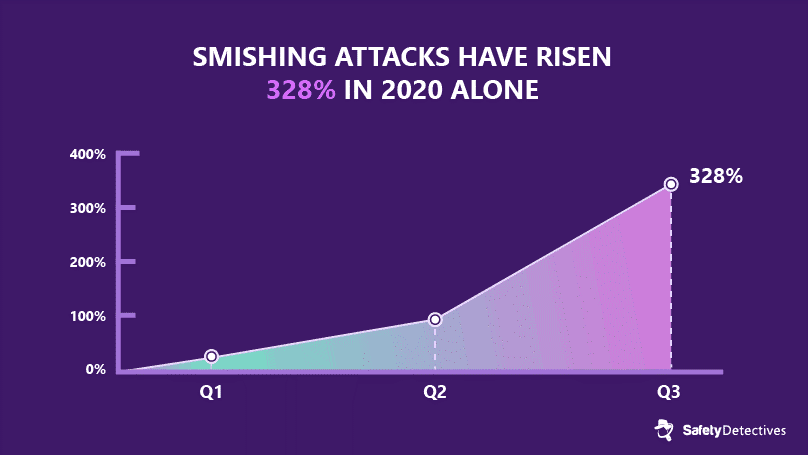
In the age of smartphones and apps emerging every other second, it may appear that the concept of traditional SMS messaging is almost on the verge of extinction. But that’s really not true. In fact, if we look at the numbers, it is clear that SMS is still the king of all communication channels. Let’s see how!

Application-to-person (A2P) SMS revenues worldwide from 2020 to 2025
(in billion U.S. dollars)
- 66.5% of consumers signed up to receive text messages from more brands over the past year
- 19% of consumers are interested in hearing from their favorite brands via text message once per day
- The average open rate for SMS is 95%
From the above-mentioned stats, it is evident that SMS still offers a great impact on business use. As the popularity of SMS for business use grows, it also grows new opportunities for fraudsters to target subscribers and operators.
What is SMS Fraud?
SMS fraud is any type of fraudulent activity that involves luring the victims into revealing personal information or installing malware through the means of SMS. Stats reveal that 59.4 million Americans have fallen victim to a phone scam in the past 12 months. Moreover, Only 65% of Americans said they would delete a text they received from an unknown number.
What are Different Types of SMS Frauds?
There are many different ways through which fraudsters can make use of SMS as the primary channel to execute their malicious intent. Let us take a look at the details about different types of SMS fraud and SMS fraud detection and prevention techniques.
SMS Spoofing
This type of SMS fraud occurs when the sender’s information on a text is altered so that the recipient sees an alphanumeric code or address rather than the sender’s mobile number. Though SMS Spoofing is not illegal and is being used by many legitimate businesses, it is also used by hackers to mimic messages from legitimate businesses. Some common examples of fraudsters using this technique are pretending to be from a bank or any trusted business/brand.
Since the sender’s address appears to be trustworthy, the recipients can easily be tricked to click on links, which may lead to the installation of malware or can extract personal information by redirecting to a phishing website.
Smishing
 This attack technique is the SMS equivalent of email phishing which means the target is tricked to provide personal information like bank details or download malware by clicking on malicious links sent through the SMS. Now, it’s clear that Smishing attacks make use of an element of spoofing which we have discussed above.
This attack technique is the SMS equivalent of email phishing which means the target is tricked to provide personal information like bank details or download malware by clicking on malicious links sent through the SMS. Now, it’s clear that Smishing attacks make use of an element of spoofing which we have discussed above.
These types of attacks are getting sophisticated as fraudsters use different types of social engineering tactics to collect information about the target. This may include the address, credit/debit cards used, and banks with which the target is associated. The motive behind gathering this information is to create very realistic Messages so that the victim gets misled easily.
SMS Grey Routes
Though these routes do not impact the end user directly, they do have an adverse effect on the mobile SMS ecosystem. These types of routes are adopted by rogue mobile operators with the motive to A2P SMS messages as P2P traffic so that they can benefit from lesser rates. However, such a practice affects telecom providers as they are not being fully remunerated for the service provided to them.
SMS Spam

Every now and then, people get bombarded with SMS messages offering irrelevant discounts and deals but cannot do much about it. SMS Spamming is a way to mass distribute messages which are usually done by unprincipled businesses. Although users can block and report the mobile numbers of spammers, these measures appear ineffective as spammers have a vast pool of mobile phone numbers to choose from. So ultimately, it is the responsibility of the SMS service providers to eliminate spam messages from their channel before it lands on the subscriber’s mobile phone.
What is the Impact of SMS Fraud?
Want to know the extent of damage SMS fraud has caused in recent years? Well, as per stats, in 2020 alone, scam texts cost Americans $86 million. Also, from January 1, 2020, to April 14th, 2022, people have lost $16.01 million to text scams related to Covid-19 and Stimulus.
How to Prevent SMS Fraud?
 Every SMS Provider wants his services to be free from any kind of SMS fraud or SMS spam. With the help of SMS platform providers like REVE SMS Platform that come with an in-built SMS Firewall feature, providers can really stand confident against spammers and fraudsters.
Every SMS Provider wants his services to be free from any kind of SMS fraud or SMS spam. With the help of SMS platform providers like REVE SMS Platform that come with an in-built SMS Firewall feature, providers can really stand confident against spammers and fraudsters.
REVE SMS Platform with Firewall System
We already know that a firewall is an effective security tool being used for years now. So having an SMS Platform with Firewall as a built-in feature will help in minimizing the security threats and thus ensure that your SMS service is safe from spammers and fraudsters.
Some of the major security functions performed by the REVE SMS Firewall feature are:
- Blocking unsolicited SMS before they get delivered to the subscribers
- Whitelisting SMS content to prevent SMS Spam
- Helps in keeping a check on delivery routes
- Keeps the system updated with the latest database of malicious numbers and URLs so that they get blocked automatically.
To know more, please get in touch with us. You can also read our post on How SMS Gateway works?




























